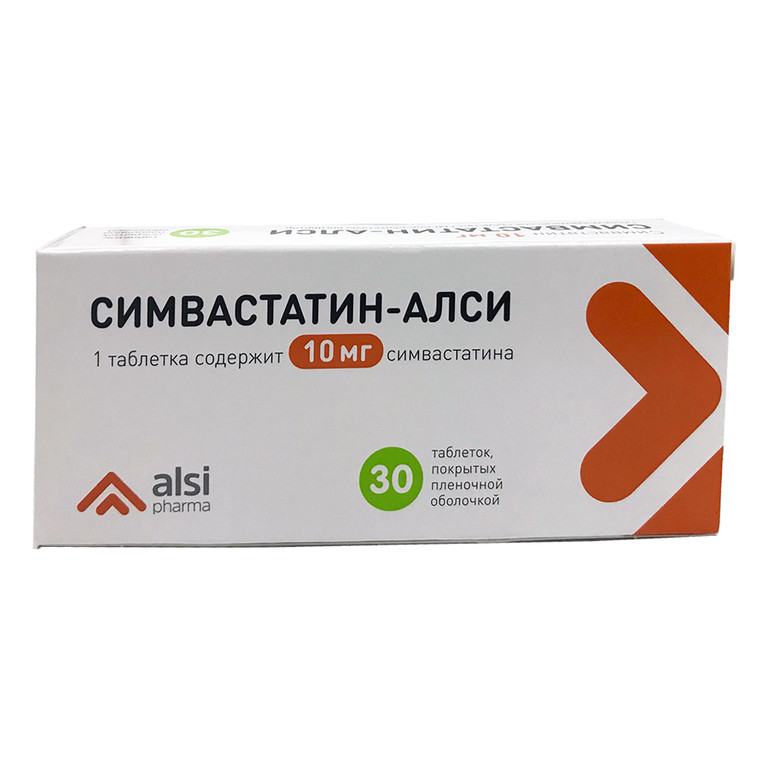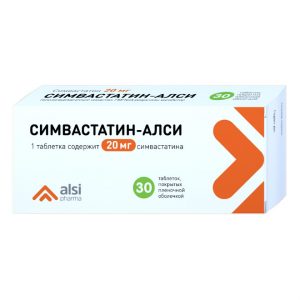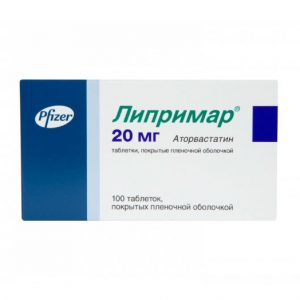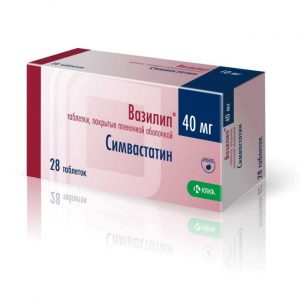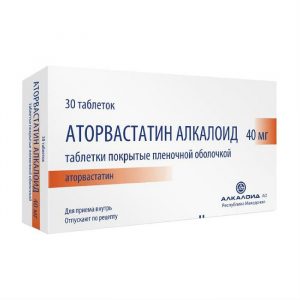Description
release form
film-coated tablets
Packing
30 pcs
Pharmacological action
SIMVACARD – a lipid-lowering drug obtained synthetically from the fermentation product Aspergillus terreus, is an inactive lactone, is hydrolyzed in the body to form a hydroxy acid derivative. The active metabolite suppresses HMG-CoA reductase, an enzyme that catalyzes the initial formation of mevalonate from HMG-CoA. Since the conversion of HMG-CoA to mevalonate is an early stage in the synthesis of cholesterol, the use of simvastatin does not cause the accumulation of potentially toxic sterols in the body. HMG-CoA is easily metabolized to acetyl-CoA, which is involved in many synthesis processes in the body. It reduces the concentration of TG, LDL, VLDL and total cholesterol in plasma (in cases of heterozygous familial and non-familial forms of hypercholesterolemia, with mixed hyperlipidemia, when an increase in cholesterol is a risk factor). Increases HDL concentration and reduces the ratio of LDL / HDL and total cholesterol / HDL. The onset of action is 2 weeks after the start of administration, the maximum therapeutic effect is after 4-6 weeks. The effect persists when treatment is continued when therapy is stopped, the cholesterol content returns to its original level (before treatment).
Indications
Primary type IIa and type IIb hypercholesterolemia (with ineffective diet therapy in patients with an increased risk of coronary atherosclerosis), combined hypercholesterolemia and hypertriglyceridemia, hyperlipoproteinemia, which is not amenable to physical exercise correction and special diet. Prevention of myocardial infarction (to slow the progression of coronary atherosclerosis), stroke and transient disorders of cerebral circulation.
Contraindications
hypersensitivity, liver failure, acute liver disease, increased activity of liver transaminases of unknown origin, pregnancy, lactation, age up to 18 years (safety and efficacy have not been established).
Use during pregnancy and lactation
Simvastatin may have an adverse effect on the fetus and is contraindicated in pregnant women. There are several reports of the development of abnormalities in newborns whose mothers took Simvastatin.
Women of reproductive age taking Simvastatin should avoid conception. The use of simvastatin is not recommended in women of childbearing age who do not use contraceptives. If pregnancy does occur during treatment, Simvastatin should be canceled, and the woman should be warned of a possible danger to the fetus.
There are no data on the excretion of simvastatin with breast milk. If it is necessary to prescribe Simvastatin during breastfeeding, it should be borne in mind that many drugs are excreted in breast milk, and there is a risk of severe reactions, therefore breastfeeding while taking the drug is not recommended.
Composition
1 tablet contains:
Active ingredient:
simvastatin – 10 mg
excipients: microcrystalline cellulose – 70.00 mg, pregelatinized starch – 49.98 mg, lactose monohydrate (milk sugar, lemon – 7.00 mg) acids monohydrate – 1.25 mg, magnesium stearate – 0.75 mg, colloidal silicon dioxide (aerosil) – 0.75 mg, ascorbic acid – 0.25 mg, butyl hydroxyanisole – 0.02 mg film coating – Opadry II (series 85 ) – 6.00 mg (polyvinyl alcohol – 2.39 mg, macrogol (polyethylene glycol) – 1.21 mg, titanium dioxide – 1.00 mg, talc – 0, 90 mg yellow iron oxide dye – 0.29 mg, red iron oxide dye – 0.19 mg, black iron oxide dye – 0.02 mg).
Dosage and administration
Inside, once a day, in the evening, drinking plenty of water. The time of taking the drug should not be associated with a meal.
Before starting treatment with simvastatin, the patient should be prescribed a standard hypocholesterol diet, which must be observed throughout the course of treatment.
The recommended dose of simvastatin for the treatment of hypercholesterolemia varies from 10 to 80 mg once daily in the evening. The recommended starting dose for patients with hypercholesterolemia is 10 mg. The maximum daily dose is 80 mg.
Changes (selection) of the dose should be carried out at intervals of 4 weeks. In most patients, the optimal effect is achieved when taking the drug in doses up to 20 mg / day.
In patients with homozygous hereditary hypercholesterolemia, the recommended daily dose of Simvastatin is 40 mg once daily in the evening or 80 mg in 3 divided doses (20 mg in the morning, 20 mg in the afternoon and 40 mg in the evening).
In the treatment of patients with coronary artery disease or a high risk of developing coronary artery disease, effective doses of simvastatin are 20 40 mg / day. Therefore, the recommended initial dose in such patients is 20 mg / day. Changes (selection) of the dose should be carried out at intervals of 4 weeks, if necessary, the dose can be increased to 40 mg / day. If the LDL content is <75 mg / dl (1.94 mmol / L), the total cholesterol content is <140 mg / dl (3.6 mmol / L), the dose should be reduced. In elderly patients and patients with mild or moderate renal failure, a change in the dosage of the drug is not required. In patients with chronic renal failure (Cl creatinine <30 ml / min) or receiving cyclosporine, danazol, gemfibrozil or other fibrates (except fenofibrate), nicotinic acid in lipid lowering doses (? 1 g / day) in combination with simvastatin, the maximum recommended dose of simvastatin is not should exceed 10 mg / day. For patients taking amiodarone or verapamil at the same time as simvastatin, the daily dose should not exceed 20 mg. Side effects of the Digestive system: constipation, diarrhea, loss of appetite, flatulence, nausea, abdominal pain, pancreatitis, increased activity of ALT, AST, GGT, alkaline phosphatase. From the side of the central nervous system and peripheral nervous system: headache, dizziness, muscle cramps, paresthesia, peripheral neuropathy. From the cardiovascular system: transient arterial hypotension is possible. From the musculoskeletal system: myalgia, myopathy, rhabdomyolysis, increased activity of CPK. Allergic reactions: rarely – angioedema, lupus-like syndrome, vasculitis, thrombocytopenia, eosinophilia, increased ESR, arthritis, urticaria, fever, shortness of breath. Dermatological reactions: photosensitivity, skin rash, itching, flushing of the skin, alopecia. Other: anemia. Drug Interaction Cytostatics, antifungal agents (ketoconazole, itraconazole), fibrates, high doses of nicotinic acid, immunosuppressants, erythromycin, clarithromycin, telithromycin, HIV risk, protease inhibitors, HIV Cyclosporine or danazol: the risk of myopathy / rhabdomyolysis is increased when ciclosporin or danazol are co-administered with high doses of Simvastatin. Other hypolipidemic agents that can cause myopathy: the risk of developing myopathy increases with the co-administration of other lipid-lowering agents, which are not potent CYP3A4 inhibitors but capable of causing myopathy in monotherapy. Such as gemfibrozil and other fibrates (except fenofibrate), as well as nicotinic acid in a dose 1 g per day. Amiodarone and verapamil: the risk of developing myopathy increases with the co-administration of amiodarone or verapamil with high doses of Simvastatin. Diltiazem: The risk of myopathy increases slightly in patients receiving diltiazem concomitantly with Simvastatin at a dose of 80 mg. Simvastatin potentiates the effects of oral anticoagulants (eg, fenprocoumon, warfarin) and increases the risk of bleeding, which requires the control of blood coagulation before treatment is started, as well as often enough during the initial period of therapy. Once a stable level of prothrombin time or International Normalized Attitude (INR) is reached, its follow-up should be conducted at intervals recommended for patients receiving anticoagulation therapy. When changing the dosage or discontinuing Simvastatin, prothrombin time or MNO should also be monitored according to the above schedule. Simvastatin therapy does not cause changes in prothrombin time and bleeding risk in patients not taking anticoagulants. Increases the level of digoxin in blood plasma. Cholestyramine and colestipol reduce bioavailability (Simvastatin may be administered 4 hours after administration of these drugs, with an additive effect). Grapefruit juice contains one or more components that inhibit CYP3A4 and can increase blood plasma concentrations of CYP3A4 metabolites. The increase in activity of inhibitors of HMG-CoA reductase after the use of 250 ml of juice per day is minimal and has no clinical significance. However, consumption of a large volume of juice (more than 1 liter per day) when taking Simvastatin significantly increases the level of inhibitory activity against HMG-CoA reductase in blood plasma. In this connection, it is necessary to avoid consuming grapefruit juice in large quantities. Overdose No specific symptoms were identified in any of the several known cases of overdose (maximum accepted dose of 450 mg). Treatment: induce vomiting, accept activated charcoal. Symptomatic therapy. Functions of the liver and kidneys, the level of CPK in serum, should be monitored. In the development of myopathy with rhabdomyolysis and acute renal failure (a rare but severe side effect), immediately discontinue the drug and introduce diuretic and sodium bicarbonate to the patient (intravenous infusion). If necessary, hemodialysis is indicated. Rhabdomyolysis can cause hyperkalemia, which can be eliminated by intravenous administration of calcium chloride or gluconate calcium, glucose infusion with insulin, use of potassium ion exchangers or, in severe cases, using hemodialysis. Storage conditions In a dry, dark place at a temperature of no higher than 25 ° C. Expiration 3 years. Deystvuyuschee substances Simvastatin pharmacy terms and conditions pharmacy terms pharmacy terms and conditions Prescription Dosage form dosage form tablets
